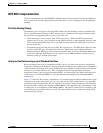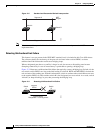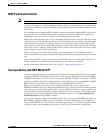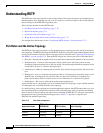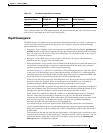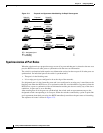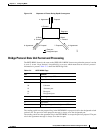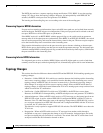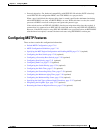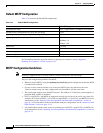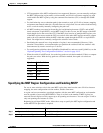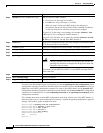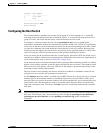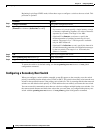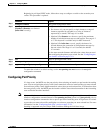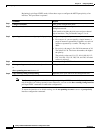
17-15
Catalyst 2960 and 2960-S Switch Software Configuration Guide
OL-8603-09
Chapter 17 Configuring MSTP
Configuring MSTP Features
• Protocol migration—For backward compatibility with IEEE 802.1D switches, RSTP selectively
sends IEEE 802.1D configuration BPDUs and TCN BPDUs on a per-port basis.
When a port is initialized, the migrate-delay timer is started (specifies the minimum time during
which RSTP BPDUs are sent), and RSTP BPDUs are sent. While this timer is active, the switch
processes all BPDUs received on that port and ignores the protocol type.
If the switch receives an IEEE 802.1D BPDU after the port migration-delay timer has expired, it
assumes that it is connected to an IEEE 802.1D switch and starts using only IEEE 802.1D BPDUs.
However, if the RSTP switch is using IEEE 802.1D BPDUs on a port and receives an RSTP BPDU
after the timer has expired, it restarts the timer and starts using RSTP BPDUs on that port.
Configuring MSTP Features
These sections contain this configuration information:
• Default MSTP Configuration, page 17-16
• MSTP Configuration Guidelines, page 17-16
• Specifying the MST Region Configuration and Enabling MSTP, page 17-17 (required)
• Configuring the Root Switch, page 17-19 (optional)
• Configuring a Secondary Root Switch, page 17-20 (optional)
• Configuring Port Priority, page 17-21 (optional)
• Configuring Path Cost, page 17-23 (optional)
• Configuring the Switch Priority, page 17-24 (optional)
• Configuring the Hello Time, page 17-25 (optional)
• Configuring the Forwarding-Delay Time, page 17-25 (optional)
• Configuring the Maximum-Aging Time, page 17-26 (optional)
• Configuring the Maximum-Hop Count, page 17-26 (optional)
• Specifying the Link Type to Ensure Rapid Transitions, page 17-27 (optional)
• Designating the Neighbor Type, page 17-27 (optional)
• Restarting the Protocol Migration Process, page 17-28 (optional)



